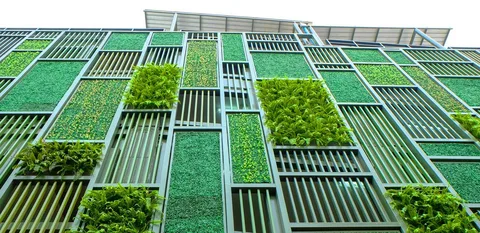Sustainable architecture is a transformative approach to building design and construction that prioritises environmental responsibility, energy efficiency, and resource conservation. Sustainable architecture offers many benefits beyond aesthetics by embracing principles that harmonise human needs with ecological balance. From economic savings to environmental preservation, it is a cornerstone of modern, forward-thinking construction.

1. Environmental Benefits
One of the primary objectives of sustainable architecture is to reduce the negative environmental impact of buildings. This approach minimizes the use of non-renewable resources, lowers carbon emissions, and conserves natural ecosystems. Key environmental benefits include:
- Energy Efficiency: Incorporating energy-efficient systems, such as solar panels, LED lighting, and high-performance insulation, reduces energy consumption. Passive solar design strategies further optimize natural light and ventilation.
- Resource Conservation: Sustainable buildings often use recycled and locally sourced materials, which reduce the need for new raw materials and minimize waste.
- Reduction of Urban Heat Island Effect: Green roofs and vegetation-covered facades help combat urban heat islands by lowering surface temperatures and improving air quality.
2. Economic Benefits
Though initial investments in sustainable architecture might be higher, the long-term savings often outweigh the upfront costs. The economic advantages include:
- Lower Utility Bills: Energy-efficient systems and renewable energy sources significantly reduce electricity, heating, and cooling expenses.
- Increased Property Value: Sustainable buildings often command higher resale values due to their operational efficiency and modern appeal.
- Tax Incentives: Many governments provide financial incentives, such as tax credits or rebates, for adopting green building practices.
3. Health and Well-Being
Sustainable architecture promotes healthier indoor environments, leading to better physical and mental well-being for occupants. This is achieved through:
- Improved Air Quality: Low-emission materials and proper ventilation systems reduce the presence of toxins, allergens, and pollutants in the air.
- Natural Light and Views: Maximising access to natural light enhances mood, productivity, and overall health while reducing reliance on artificial lighting.
- Comfortable Indoor Climate: Advanced insulation and climate control systems maintain consistent and comfortable indoor temperatures.
4. Social Benefits
Sustainable architecture fosters community well-being and inclusivity by creating spaces that are functional, aesthetic, and accessible. Key social benefits include:
- Enhanced Community Engagement: Green public spaces, like parks and community gardens, encourage social interactions and foster a sense of community.
- Education and Awareness: Sustainable buildings often serve as examples of eco-friendly practices, inspiring others to adopt similar principles.
- Equity and accessibility: Designing for inclusivity ensures that buildings accommodate individuals with varying needs, promoting equality.
5. Energy Independence
By utilising renewable energy sources such as solar, wind, and geothermal, sustainable buildings contribute to reducing reliance on fossil fuels. This shift not only cuts down on energy costs but also enhances energy security, making communities less vulnerable to fluctuations in energy supply and prices.
6. Resilience to Climate Change
Sustainable architecture is designed with adaptability and durability in mind, making it well-suited to withstand the challenges posed by climate change. Features such as rainwater harvesting, flood-resistant structures, and energy-efficient systems help buildings remain functional during extreme weather events.
7. Waste Reduction
Efficient construction methods and material selection are integral to sustainable architecture, leading to significant reductions in waste. Practices like modular construction, prefabricated components, and construction debris recycling ensure that resources are used judiciously.
8. Technological Innovation
Sustainable architecture drives technological advancement by integrating cutting-edge solutions into building design and operations. Smart home technologies, energy monitoring systems, and advanced construction materials improve efficiency and make sustainable living more accessible and appealing.
9. Aesthetic Appeal and Functional Design
Sustainable buildings often blend seamlessly with their surroundings, showcasing innovative designs that prioritise functionality. Architects use natural elements, such as greenery and water features, to create visually appealing and harmonious spaces that enhance the user experience.
Conclusion
The benefits of sustainable architecture extend far beyond the buildings themselves. By reducing environmental impact, cutting costs, and improving quality of life, sustainable practices set a new standard for construction and urban development. As awareness grows and technology advances, sustainable architecture will continue to shape the future, fostering a world where human activity coexists harmoniously with nature.


Pingback: Top Architects in Coimbatore